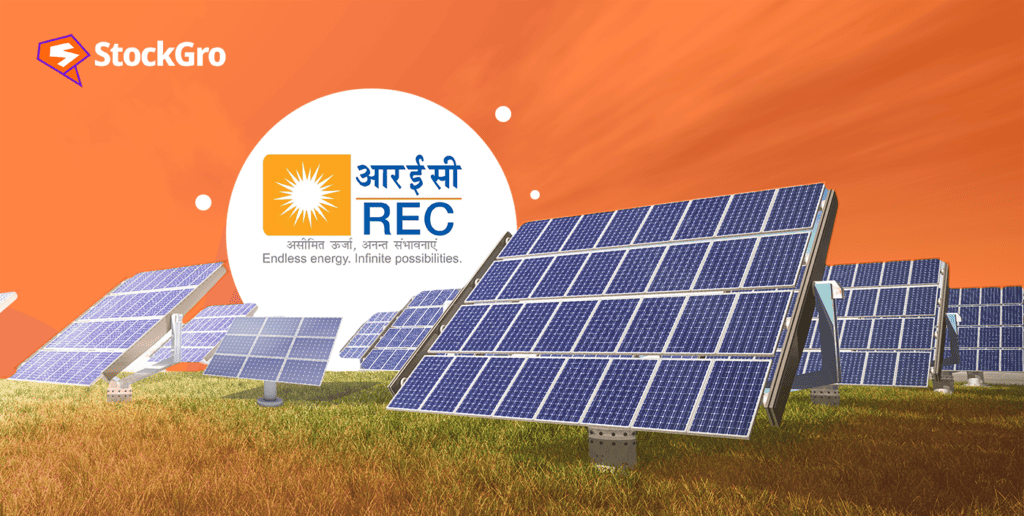
As India targets an ambitious renewable energy capacity addition, state-owned lenders like the Rural Electrification Corporation Ltd. (REC) are stepping up with massive funding support. REC recently unveiled a ₹1.2 trillion credit line to install REC group’s solar panels in 10 million households under the Suryodaya scheme.
What does this renewable push mean for REC’s growth and investment potential? Should investors leverage this opportunity? Read on to learn about the initiative of REC’s solar panels in India, the competitive scenario, financial health, and more.
Also read:The renewable energy industry in India: A game-changer for the environment
REC solar panels: Expects 10 million installations with a ₹1.2 trillion credit line
Vivek Kumar Dewangan, Chairman and Managing Director of the state-run REC, said that the Pradhan Mantri Suryodaya Yojana would install rooftop solar systems in 10 million homes. Through the scheme, the state-owned REC will provide loans of up to ₹1.2 trillion to finance the installation of solar panels on residential rooftops.
To execute this policy, Dewangan briefed the press that the board of REC has approved a credit line of around ₹15,000 crore each for eight central public sector enterprises (CPSEs), which would function as renewable energy service providers.
They announced their intention to support the rooftop solar programme with a line of credit of up to ₹1.20 lakh crore.
Additionally, they will be taking the initiative to install solar panels on rooftops using the RESCO (renewable energy service company) model. According to this model, the renewable energy service company develops, finances, and owns the project and sells power to the consumer or the grid.
With a goal of reaching one crore households in one year, the Ministry of New and Renewable Energy has assigned REC the responsibility of implementing rooftop solar across the nation. To carry out the initiative, CPSEs under the Ministry of Power have been given control over states and union territories.
By 2026, REC solar panel distributors aim to authorise 40 GW of rooftop solar systems. Following Prime Minister Modi’s announcement on January 22, 2024, of a rooftop solar project for residences, REC plans to reach more than 10 GW of this goal in the next year.
How will solar panels impact the economy and the environment?
Solar panels may have positive impacts on both the environment and the economy. Here’s how:
Environmental benefits: Solar panels help reduce carbon emissions, greenhouse gas emissions, and our dependency on fossil fuels. This, in the long run, may help mitigate the effects of climate change by providing clean energy.
Economic benefits: Installing solar panels means lowering your utility bills. Not only that, solar panel installation may also lead to creating jobs and assisting during emergencies. Along with boosting the local economy by supporting the solar industry.
Also read: Green tycoons unite: Adani & TotalEnergies’ $300M eco-venture!
REC competitors
Some of the competitors of REC Ltd. ranked by market capitalisation (₹ cr.) as of January 25, 2024, are:
- Power Finance Corporation Ltd. (138,274.26)
- SBI Cards & Payment Services Ltd. (72,244.89)
- IFCI Ltd. (13,145.16)
Evolution of REC
The Rural Electrification Corporation Ltd. (REC) is a government-owned enterprise that provides funding to private companies, state power providers, and electricity boards across the nation. Across India, the organisation is promoting and funding transmission, distribution, and generation projects.
Established in 1969 in the aftermath of the famines of the 1960s, the Rural Electrification Corporation (REC) aimed to improve the lives of people living in rural and semi-urban areas by increasing access to power for agricultural pump sets.
From then on, REC branched out into other areas and expanded its mission until it became the leader in the power sector’s financial and advisory services. Kolkata became the site of the corporation’s first regional headquarters in 1974. In 1975, the company offered bonds to the public for the first time.
In 1997, REC was officially recognised as a “Miniratna” company. A miniratna company is a public sector enterprise that has profits for three consecutive years and some autonomy and financial powers from the government.
The RBI issued REC a certificate of registration, enabling the company to conduct non-banking financial company (NBFC) operations. In 2008, REC went public with an IPO that was 27 times oversubscribed due to enormous interest in the company. Also, the Indian government recognised REC with the prestigious “Navratna” status. Companies with Navratna status may invest up to ₹1000 crores without any approval from the government.
Amazingly, REC’s Follow-on Public Offering (FPO) in 2010 was oversubscribed as well.
On January 23, REC Ltd. announced a net profit of ₹3,269.3 crore for the quarter that ended in December 2023. This is a 13.6% increase over the same period the previous year. During the third quarter of the previous fiscal year, the company’s net profit was ₹2,878 crore.
Investing in REC Ltd.
Pros
- REC Ltd. has a low price-to-earnings ratio of 9.05, which means it is undervalued compared to the sector PE of 17.22.
- REC Ltd. is one of the consistently highest return stocks over five years in the Nifty500 index, which consists of the top 500 companies by market capitalisation in India.
- The company is making good use of its capital to generate profits—ROCE has been on the rise during the last two years.
- REC Ltd. has a high dividend yield of 2.68%, which means it pays a generous amount of dividends to its shareholders.
Cons
- REC Ltd. has a high debt-to-equity ratio of 6.62, which means it relies heavily on debt to finance its assets. This means REC Ltd. has more liabilities than equity, which increases its financial risk.
- REC Ltd. operates in a competitive and cyclical industry, which may expose it to fluctuations in demand and supply of power as well as price volatility.
Financials
REC’s net profit increased from ₹3,269 crores, a rise of 14% year-on-year, on a standalone basis. There was a staggering year-on-year increase of 177% in its loan sanctions, from ₹47,712 crores to ₹1,32,049 crores.
In the present scenario of REC, with an increase of 18% to ₹4,159 crore for the period from October to December, the company announced its net interest income (NII) recently. Also, compared to the previous year, the net profit for the quarter increased by 14% to ₹3,269.3 crore.
As of December 2023, the company’s Capital Risk Adequacy Ratio (CRAR) was a healthy 28.21%, indicating that there is plenty of room to sustain future expansion.
| Metric | Value |
| Market cap (₹ Cr.) | 123,801.03 |
| Book value per share (₹) | 192.75 |
| Dividend Yield | 2.68% |
| ROCE | 12.42% (as of March 2023) |
| ROE | 19.41% |
| Face value (₹) | 10 |
Also read: The role of the energy sector in powering India’s growth.
Shareholding pattern of REC
The shareholding pattern (as of December 2023) of REC is as follows:
Promoters: 52.63%
Foreign Institutional Investors (FIIs): 20.6%
Domestic Institutional Investors (DIIs): 14.2%
Public: 12.55%
Conclusion
In summary, REC has pledged massive funding support for installing solar rooftops across India. Evaluating factors like financial health, market dynamics, and the growth impact of this renewable push will help you understand REC’s investment appeal.

